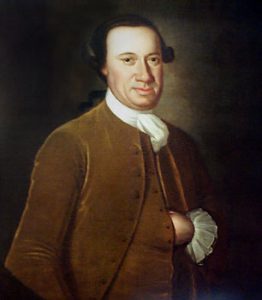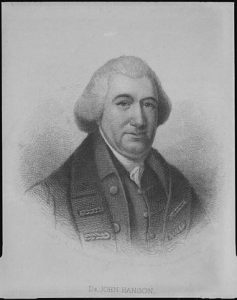By Suzanne Sparrow Watson
 My New Year’s resolution this year was to tune out the news. As a result, the satellite radio in my car now plays either music or comedy. So far I’ve been much happier and less depressed so I guess the old saying, “Ignorance is bliss” is true. But that’s a discussion for another time. Today, apropos to the holiday, I want to share something I learned while listening to the “60’s on 6” program on Sirius XM. The host asked who the first President of the United States was. You just know when they ask such an obvious question that the answer will come out of left field. Sure enough, a couple of minutes later a guy called in and said the answer was John Hanson. “Yep!”, cried the host. I just about drove off the road. I consider myself a pretty good student of history. I minored in it in college and to this day every other book I read is a history book of some sort. I’ve never even heard of this Hanson fellow. The whole thing sounded bogus to me. What about George? What about his chopping down the cherry tree and smiling with his wooden teeth? Was everything I learned in school wrong? I went in search of the answer.
My New Year’s resolution this year was to tune out the news. As a result, the satellite radio in my car now plays either music or comedy. So far I’ve been much happier and less depressed so I guess the old saying, “Ignorance is bliss” is true. But that’s a discussion for another time. Today, apropos to the holiday, I want to share something I learned while listening to the “60’s on 6” program on Sirius XM. The host asked who the first President of the United States was. You just know when they ask such an obvious question that the answer will come out of left field. Sure enough, a couple of minutes later a guy called in and said the answer was John Hanson. “Yep!”, cried the host. I just about drove off the road. I consider myself a pretty good student of history. I minored in it in college and to this day every other book I read is a history book of some sort. I’ve never even heard of this Hanson fellow. The whole thing sounded bogus to me. What about George? What about his chopping down the cherry tree and smiling with his wooden teeth? Was everything I learned in school wrong? I went in search of the answer.
It turns out that there is a contingent who support the notion that Hanson was our first President. Conveniently, most of those people are his descendants. For what it’s worth, here’s a bit of history on him and after reading this you can form your own opinion. In 1661 John Hanson’s grandfather came to America as an indentured servant. Two generations later John was born in 1721 to what was by then a very wealthy and prominent family. Little is known about his early life but his career in public service began in 1750, when he was appointed sheriff of Charles County. He then served in the Maryland General Assembly for twelve years before moving to Frederick County where he held a variety of offices, including deputy surveyor, sheriff, and county treasurer. He was one busy guy and, if nothing else, may have been our first professional politician. When relations between Great Britain and the colonies soured in 1774, Hanson became one of Frederick County’s leading Patriots. He was known for his organization skills in gathering supplies to use against the Tories and even paid the rag tag Revolutionary forces out of his own pocket. Think about that – do you see any of our current elected officials dipping into their own funds? So we have to assume he was a dedicated guy.
In December 1779, the Revolutionary War victorious for the Patriots, the Maryland House of Delegates named Hanson to the Second Continental Congress; he began serving in Congress in Philadelphia in June 1780. On November 5, 1781, Congress elected Hanson as its president. And this is where the controversy begins. Under the Articles of Confederation, the United States had no executive branch; the president of Congress was a mostly ceremonial position. The office did require Hanson to serve as neutral discussion moderator, handle official correspondence, and sign documents which sounds to me like he was a high-priced arbitrator. Apparently Hanson didn’t think much of his duties either because he is said to have found the work tedious and considered resigning after just one week, citing his poor health and family responsibilities. I think that was the precursor to “resigning to pursue other opportunities” excuse. Out of a sense of duty Hanson remained in office, and though he obviously was trying to squirm out of the job, the Maryland Assembly reelected him as a delegate on November 28, 1781, and he continued to serve as president until November 4, 1782. He died 11 days later so maybe he really was sick.
In 1898, Douglas H. Thomas, a descendant of Hanson, wrote a biography promoting Hanson as the first true President of the United States. Thomas became the driving force behind the selection of Hanson as one of the two people who would represent Maryland in the National Statuary Hall Collection in Washington, D.C. His statue was completed in 1903 and can still be seen today in the Senate connecting corridor. His selection as one of the two bronzes to represent Maryland has been controversial from the start, with many contemporary historians citing others who were more deserving. As recently as 2011, Maryland lawmakers have considered replacing Hanson’s statue in Statuary Hall with one of Harriet Tubman. In any event, the argument as to whether Hanson was the first President was further promulgated in a 1932 biography of Hanson by journalist Seymour Wemyss Smith. Again, historians dismissed Smith’s viewpoint because his research was less than stellar.
The most compelling argument as to why we consider George Washington, not John Hanson, our first President is that Washington was the first to have true executive powers under the Constitution. That seems like a sensible argument to me. The one thing that became clear in my reading is that John Hanson’s reputation has been commemorated far more than most of his contemporaries, other than the Founding Fathers. In 1972, he was depicted on a 6-cent US postal card, which featured his name and portrait next to the word “Patriot”. In 1981, Hanson was featured on a 20-cent US postage stamp. U.S. Route 50 between Washington D.C. and Annapolis is named the John Hanson Highway in his honor. There are also middle schools located in Oxon Hill, Maryland, and Waldorf, Maryland, named after him. A former savings bank named for him until it went under during the savings and loan crisis. And maybe that is the fitting end for his legacy given that most serious researchers consider his elevation to the “first President of the United States” to be based on an old hoax.


